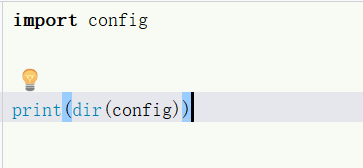flask config笔记

#从flask这个包中导入Flask这个类 #Flask这个类是项目的核心,以后很多操作都是基于这个类的对象 #注册url、注册蓝图等都是基于这个类的对象 from flask import Flask import config #配置文件 #创建一个Flask对象,传递__name__参数进去 #__name__参数的作用: #1.可以规定模板和静态文件的查找路劲 #2.以后一些Flask插件,比如Flask-migrate、Flask-SQLAlchemy如果报错了, #那么Flask可以通过这个参数找到具体的报错位置 app = Flask(__name__) # app.debug = True #第二中模式debug # app.config.update(DEBUG=True)#第三种模式 #可以看出config其实是一个字典 app.config.from_object(config) #第四种模式,从配置文件中导入
#为什么config的debug必须是大写
我们看下
from_object的源码
def from_object(self, obj):
"""Updates the values from the given object. An object can be of one
of the following two types:
- a string: in this case the object with that name will be imported
- an actual object reference: that object is used directly
Objects are usually either modules or classes. :meth:`from_object`
loads only the uppercase attributes of the module/class. A ``dict``
object will not work with :meth:`from_object` because the keys of a
``dict`` are not attributes of the ``dict`` class.
Example of module-based configuration::
app.config.from_object('yourapplication.default_config')
from yourapplication import default_config
app.config.from_object(default_config)
You should not use this function to load the actual configuration but
rather configuration defaults. The actual config should be loaded
with :meth:`from_pyfile` and ideally from a location not within the
package because the package might be installed system wide.
See :ref:`config-dev-prod` for an example of class-based configuration
using :meth:`from_object`.
:param obj: an import name or object
"""
if isinstance(obj, string_types):
obj = import_string(obj)
for key in dir(obj):#这里用dir()内置函数查看文件参数
if key.isupper():#这里判断了必须大写
self[key] = getattr(obj, key)这里获取debug的值


再看下from_pyfile的源码
def from_pyfile(self, filename, silent=False): """Updates the values in the config from a Python file. This function behaves as if the file was imported as module with the :meth:`from_object` function. :param filename: the filename of the config. This can either be an absolute filename or a filename relative to the root path. :param silent: set to ``True`` if you want silent failure for missing files. .. versionadded:: 0.7 `silent` parameter. """ filename = os.path.join(self.root_path, filename) d = types.ModuleType('config') d.__file__ = filename # try: with open(filename, mode='rb') as config_file: exec(compile(config_file.read(), filename, 'exec'), d.__dict__) except IOError as e: if silent and e.errno in ( errno.ENOENT, errno.EISDIR, errno.ENOTDIR ): return False e.strerror = 'Unable to load configuration file (%s)' % e.strerror raise self.from_object(d) return True
第一个知识点:
d.__file__ = filename #__file__

 文件的绝对路径
文件的绝对路径
第二个知识点:
compile() 函数将一个字符串编译为字节代码。
参数source:字符串或者AST(Abstract Syntax Trees)对象。
参数 filename:代码文件名称,如果不是从文件读取代码则传递一些可辨认的值。
参数model:指定编译代码的种类。可以指定为 ‘exec’,’eval’,’single’。如果是exec类型,表示这是一个序列语句,可以进行运行;如果是eval类型,表示这是一个单一的表达式语句,可以用来计算相应的值出来;如果是single类型,表示这是一个单一语句,采用交互模式执行,在这种情况下,如果是一个表达式,一般会输出结果,而不是打印为None输出。

exec第三个知识点:
这个暂时放下


